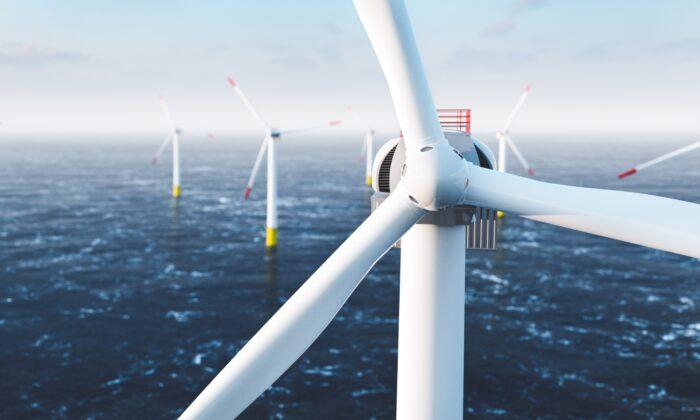A natural resource that’s remained largely untouched by development now faces colossal industrialization of wind energy along the U.S. East Coast.
Clean-ocean advocates monitoring its expansion warn that this race to construction undermines an ecosystem that will lead to catastrophic consequences.
“They’re moving at such a reckless pace without any real good science or due diligence,” Clean Ocean Action (COA) Executive Director Cindy Zipf said.
In total, what’s proposed are 3,500 turbines across 2.2 million acres of ocean—twice the size of the Grand Canyon—according to Ms. Zipf.
One turbine, at 1,046 feet, is as tall as the Chrysler Building, she said, with one blade surpassing the height of the Statue of Liberty.
On the floor of the ocean will stretch 10,000 miles of cable emitting electromagnetic fields, connected to substations that will discharge billions of gallons of hot water into the ocean per day.
Tax incentives found in the Inflation Reduction Act have triggered a gold rush of surveying and development.
While the Biden administration’s stated goal for these projects is to attain a carbon-neutral energy grid by 2030, what those who make their living from the ocean are finding is that in addition to not having any effect on climate change, the turbines will devastate what’s left of the earth’s resource that hasn’t been overdeveloped.
“Ocean life has evolved and flourished over eons of time in the quiet, dark, and wide open,” Ms. Zipf told The Epoch Times. “And now, in less than 10 years, they’re going to turn it into a very loud, very complicated concrete and steel jungle. And somehow marine life is supposed to survive.”
COA, headquartered in Long Branch, New Jersey, is focused on one of the 28 projects called the Atlantic Shore Offshore Wind (ASOW) project, a joint venture between Shell New Energies US, LLC. and EDF-RE Offshore Development, LLC., itself a subsidiary of EDF Renewables North America.
Atlantic Shores has more than 400 acres of three offshore wind areas under development located off the coast of southern New Jersey between Atlantic City and Barnegat Light, with a third offshore lease area in the New York Bight.
The ASOW projects, located 8.7 miles off the coast of New Jersey, will have 200 wind turbines throughout 102,124 acres of ocean, four offshore and two onshore substations, and 1,025 miles of high voltage cables.
COA issued a petition on June 15 demanding that the Bureau of Ocean Energy Management extend its public review and comment period from 45 days to six months.
“These projects will have serious consequences for the public use and enjoyment of the ocean, as well as significant consequences to marine life,” COA stated. “Ample time is needed to carefully and comprehensively review these projects. People who will be impacted most directly by these projects earn their living along the shore during the summer season.”

Levels of Harassment
Currently, companies are surveying the ocean for future construction, Ms. Zipf said.NOAA Issues Incidental Take Authorizations
“Provided certain findings are made, NOAA Fisheries may issue incidental take authorizations allowing the unintentional ‘take’ of marine mammals incidental to specified activities, including construction projects, scientific research projects, oil and gas development, and military exercises,” NOAA told The Epoch Times.“Take” is defined under the MMPA as “to harass, hunt, capture, or kill, or attempt to harass, hunt, capture, or kill any marine mammal.”
Amendments to the MMPA divide harassment into two levels.
Level A Harassment is the act of pursuit, torment, or annoyance that has the potential to injure a marine mammal. Level B Harassment is any act of pursuit, torment, or annoyance that disrupts behavioral patterns such as migration, breathing, nursing, breeding, and feeding.
According to one document, ASOW has applied for a Level B ITA for its site characterization surveys that involve high-resolution geophysical technology using frequencies less than 180 kilohertz spanning 1,450,006 acres from Long Island, New York, to Atlantic City, New Jersey.
NOAA stated that it hadn’t authorized permits for offshore wind surveys or construction activities that would allow for injury or death.

Whale Deaths: ‘It Is Not Normal’
Meghan Lapp, a representative for a commercial fishing company in Rhode Island who also works in fishery management, told The Epoch Times that the surveying has potentially been the cause of several whale deaths along the east coast.“It’s essentially seismic equipment they are using to characterize the seafloor so they can pile drive the turbines,” Ms. Lapp said.
The difference between what is happening along the East Coast and what has been taking place for much longer with oil and gas surveys in the Gulf of Mexico is the fact that the Gulf of Mexico doesn’t have as many whales as the East Coast, she said.
“On the East Coast, there is a superhighway of large, baleen whale species like fin whales, right whales, sei whales, humpback whales, minke whales, and this is their migration route,” she said. “When there are these overlapping surveys going on, constantly blasting them with intense sound, that has an impact.”
Among the harassments granted in the ITAs is harassment that causes temporary deafness, Ms. Lapp said.
However, temporary deafness can lead to permanent deafness if conditions persist, she added.
“And the fact is, a deaf whale is a dead whale,” Ms. Lapp said. “Now, all of a sudden, with these overlapping surveys in the same area, there are large baleen whales washing up. We know NOAA is issuing incidental take authorizations for the temporary deafness, but not for death, so there’s been a lot of public outcry about this.”
From Jan. 1 to June 21, 2023, there were 42 large whale strandings along the U.S. Atlantic coast, NOAA told The Epoch Times, a number that includes 26 humpback whales between Massachusetts and Virginia, two sperm whales in Florida and offshore North Carolina, two North Atlantic right whales in North Carolina and Virginia, one sei whale in North Carolina, 10 minke whales between Maine and New York, and one fin whale in Virginia.
NOAA said it’s been investigating what it calls unusual mortality events for large whales on the East Coast since 2016 and maintains that humans cause the whale deaths.
“Partial or full necropsy examinations were conducted on approximately half of the whales,” NOAA stated. “Of the whales examined, about 40 percent had evidence of human interaction, either ship strike or entanglement. Vessel strikes and entanglement are the greatest human threats to large whales.”
According to NOAA, connecting offshore wind surveys and whale deaths “is speculative and not supported by scientific literature or other data.”
“But NOAA doesn’t have good data on low-frequency baleen whale hearing, so they don’t know what levels of sound cause temporary or permanent deafness,” Ms. Lapp said. “They’re issuing permits that can have a significant impact on these animals without a benchmark ... to measure it against.”
According to Bonnie Brady with the Long Island Commercial Fishing Association, NOAA has no standardized protocol for checking the whale’s ears to determine deafness.
“When they say they have no direct information that shows there is a link between offshore wind and whale deaths, it’s, in effect, the perfect crime if you don’t have a method of practice by which you actually check the ears,” Ms. Brady said. “Of course, you don’t have information, and you will be guaranteed to never have information.”
“In the UK, at the height of their offshore wind activity in 2018, 1,000 whales died and washed up dead on UK beaches, and when people started to make the connection between offshore wind and dead whales, the government and the media and the offshore wind industry quashed it, and people began to think, ‘Well, this is just normal,’” Ms. Lapp said. “It is not normal.”
The Epoch Times contacted ASOW for comment but received none by press time.
In a May statement, ASOW said linking whale deaths to wind turbine construction is misinformation, blaming humans instead.
“These sad whale deaths are extremely disturbing, but it is simply inaccurate to point the finger at offshore wind activities when there is no evidence to indicate a correlation (whale deaths started increasing in 2016, years before offshore wind activities were underway), let alone a causal relationship between regular ocean seabed surveys and whale strandings,” ASOW stated in its release.
Ms. Lapp and Ms. Brady both contend that surveying predates 2016.
“Sub-bottom profiling, high resolution geophysical (HRG) surveys were alive and well beginning in 2015, with at least four sets of surveys taking place,” Ms. Brady said.
“Not all applied for Incidental Harassment Authorizations (IHA) for ITAs, but HRG surveys were done with the same equipment that would qualify as Level B and A harassment,” Ms. Brady said. “When I spoke to an NOAA representative about eight months ago, I was told an IHA is considered a service, it is not a requirement. So, there may be others that did survey work but without an IHA.”

‘This Isn’t Reasonable or Responsible’
Recently, the Government Accountability Office (GAO)—a nonpartisan agency that conducts investigations for Congress—said it would examine how the construction of coastal wind turbines is affecting the environment, the fishing industry, military operations, and navigational safety.“There’s been no comprehensive investigation into this wide-scale industrialization, so we see this GAO investigation into a really great step to getting publicly available to make sure that the ocean is protected,” Ms. Zipf said.
She added that COA supports reasonable and responsible offshore wind development.
“But right now, in looking at what’s being proposed up and down the coast, this isn’t reasonable or responsible,” Ms. Zipf said. “We need to know what the impacts are in advance in order to make informed decisions so that these green energy initiatives aren’t going to harm the resources that we’re trying to protect in the first place.”
It should be noted, she added, that the ocean is nonpartisan.
“This isn’t a Republican or Democrat issue. Everyone depends on a clean and healthy ocean. It provides so much, and we don’t have to pay a dime; we only have to ensure that it’s healthy.”





